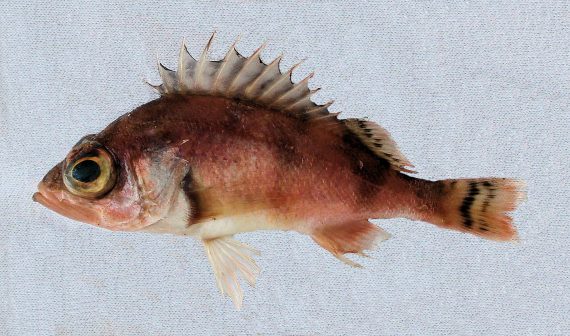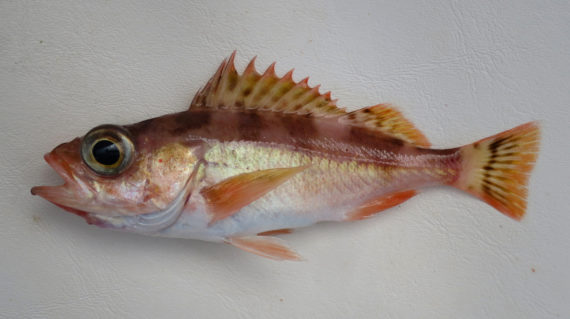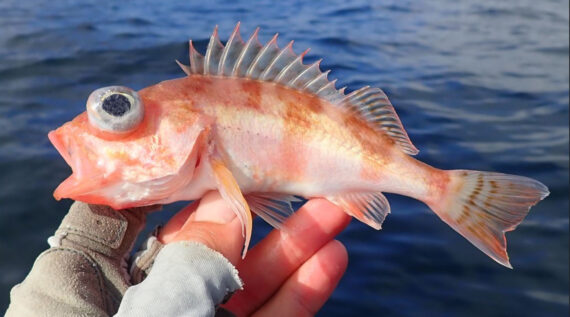Stripetail Rockfish, Sebastes saxicola
 Stripetail Rockfish, Sebastes saxicola. Fish caught from coastal waters off Point Loma, California, April 2008. Length 12.0 cm (4.7 inches). Catch courtesy of Eddie Kisfaludy, Scripps Institution of Oceanography, La Jolla, California. Fish identification courtesy of H.J. Walker, Jr., Scripps Institution of Oceanography, La Jolla, California.
Stripetail Rockfish, Sebastes saxicola. Fish caught from coastal waters off Point Loma, California, April 2008. Length 12.0 cm (4.7 inches). Catch courtesy of Eddie Kisfaludy, Scripps Institution of Oceanography, La Jolla, California. Fish identification courtesy of H.J. Walker, Jr., Scripps Institution of Oceanography, La Jolla, California.
 Stripetail Rockfish, Sebastes saxicola. Fish caught from coastal waters off Palos Verdes, California, July 2016. Length: 13 cm (5.1 inches). Catch, photograph and identification courtesy of Eli (obsessiveangling.wordpress.com).
Stripetail Rockfish, Sebastes saxicola. Fish caught from coastal waters off Palos Verdes, California, July 2016. Length: 13 cm (5.1 inches). Catch, photograph and identification courtesy of Eli (obsessiveangling.wordpress.com).
 Stripetail Rockfish, Sebastes saxicola. Fish caught from coastal waters off Newport Beach, California, December 2020. Length: 16.7 cm (6.6 inches). Catch, photograph and identification courtesy of Ben Cantrell, San Diego, California.
Stripetail Rockfish, Sebastes saxicola. Fish caught from coastal waters off Newport Beach, California, December 2020. Length: 16.7 cm (6.6 inches). Catch, photograph and identification courtesy of Ben Cantrell, San Diego, California.
The Stripetail Rockfish, Sebastes saxicola, is a member of the Rockfish and Scorpionfish or Scorpaenidae Family, and is known in Mexico as rocote cola listada. Globally, there are one hundred eight species in the genus Sebastes, of which fifty-three are found in Mexican waters, all in the Pacific Ocean.
The Stripetail Rockfish has a small and very thin body with a depth that is 34% to 38% of standard length. They range in color from yellow-pink to reddish-pink or red with subtle darker saddles across the top of their back and transition to silvery white ventrally. Their fins are dusky, with their second dorsal fin and their caudal fin having 1 or 2 prominent stripes, respectively. Their head is long and features a long snout, disproportionately large eyes, and a mid-sized terminal mouth. They are somewhat unique in that their anus is located midway between their anal and pelvic fins. Their anal fin has 3 spines and 5 to 8 rays; their caudal fin is square; their dorsal fin has 13 spines and 11 to 14 rays; and, their pectoral fins have 15 to 19 rays. They have 29 to 40 gill rakers. Their body is covered with scales.
The Stripetail Rockfish are solitary bottom dwellers found within rock structure at depths between 24 m (80 feet) and 550 m (1800 feet). They reach a maximum of 41 cm (16 inches) in length, with females being larger than males. They feed on zooplankton, copepods, and krill. Reproduction is oviparous with each female releasing up to 230,000 pelagic eggs. They are a favorite prey of salmon. They have lifespans of up to 38 years. The Stripetail Rockfish is poorly studied with very limited information available about their lifestyle and behavioral patterns including specific details on age, growth, longevity, movement patterns, diet, habitat use, and reproduction.
The Stripetail Rockfish is a resident of Mexican waters of the Pacific Ocean but has a limited distribution being found from Guerrero Negro, Baja California northward along the central and northwest coast of Baja.
The Stripetail Rockfish is most likely confused with the Halfbanded Rockfish, Sebastes semicinctus (unique diamond-shaped mark under rear portion of spiny dorsal fin), the Sharpchin Rockfish, Sebastes zacentrus (lacks strong caudal fin striping), and the Splitnose Rockfish, Sebastes diploproa (lacks caudal fin striping; dentigerous knob on both sides of snout).
From a conservation perspective the Stripetail Rockfish has not been formally evaluated. They are not of interest to either commercial or recreational anglers due to their small stature. They are retained, however, a by-catch from commercial trawls and utilized in the pet food industry. They are caught on occasion by recreational anglers but typically discarded.